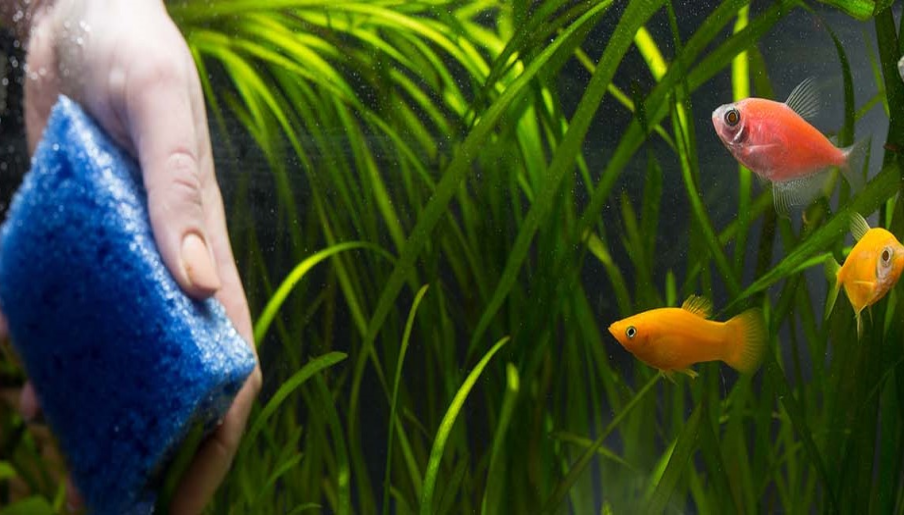In any natural aquatic environment fish and aquatic plants living together are commonplace. An aquarium would be no different. Any healthy aquarium is capable of growing plants, in fact,to most do whether we want to happen or not. Live aquarium plants are more aesthetically pleasing but, if you do not have enough of them, algae will grow in its place.
The very basic ingredients needed for growing aquatic plant life are water, light, nitrogen, phosphorus, and potassium. The last three just happen to be present (sometimes abundant) in the tap water we use to drink and fill our aquariums. Nitrogen originates from decaying fish foods, and the bacteria grown for biological filtration. Phosphorus compounds are produced as a result of improper feeding of the fish in an aquarium. Phosphorus can be present in tap water, sometimes used to prevent lead poisoning. Potassium levels are generally low in most aquariums. We can’t overlook the light. All aquariums receive light from specialized light fixtures and of course, the sunlight that enters the room.
You need to have light in your aquarium during the day as part of the behavioral needs of the inhabitants. Natural daylight can range from 8 to 12 hours per day. Aquariums need only 8 – 10 hours per day. Aquarium light bulbs are designed to enhance the colours of the fish and the aquatic plants.
You can Control Algae Growth
Aquarium hobbyists have a choice. They can either constantly clean the algae as it appears in the aquarium or create a planned solution for algae control. There are many ways to reduce the unsightly green stuff in your aquarium. The following seven steps describe the most effective methods for winning the battle against algae.
Proper Fish Feeding
This could possibly be the most significant factor leading to excessive algae growth. Uneaten food decaying in the gravel or collected in the aquarium filter creates an overabundance of algae fertilizers. The combination of ammonium, phosphate, and nitrate released by uneaten foods will quickly cause algae to grow out of control.
Manual Cleaning
Every aquarium owner should have at least one algae-cleaning device! Scrub pads, edged algae scrapers, pipe cleaners, and algae magnets should always be recommended to help maintain the appearance of any aquarium. The more often algae cleaning is performed the slower the algae growth and the easier it is to manage.
Water Exchanges
Repeated water exchanges will only dilute the plant nutrients if the replacement water contains none of those same nutrients (tap water usually does). Stripping and cleaning an aquarium will remove the algae as well as all the beneficial bacteria for biological filtration. A stripped aquarium would still grow algae rapidly especially if the same tap water is used and if there are no changes to the daily routines that led to the algae problem in the first place.
Control the Light in the Aquarium
An aquarium only needs 8 to 10 hours of light a day. When placing your aquarium in the home find a place away from direct sunlight. If the room you want the aquarium has windows in it close the curtains during the day, whenever possible. Direct or indirect sunlight can create temperature fluctuations on smaller aquariums and produce spectrums of light which will only speed the growth of the less desirable algae. We recommend an aquarium hood with aquarium lighting chosen specifically for the environment of your choosing. Operate the light source with an automatic timer set for the period you want.
Scavenging Fish
Here is a novel idea “Get fish that look great and eat algae!” The most common ones are Chinese Algae Eaters, Otocinclus, Doctor Fish, and Plecostomus but, they are not exclusive to the Algae Eating Club. There are Mollies, Platies, Kissing Gouramis, Red Tail & Rainbow Sharks, American Flag Fish, Siamensis Flying Foxes, Hill Stream Loaches, and numerous other varieties of fish.
Sure, algae eaters eat a lot of algae but, it’s only part of their diet. Supplemental foods such as Spirulina and driftwood are also necessary for their diet.
Chemical Filters
Nitrate and phosphate removers placed inside aquarium filters help to slow down algae growth by reducing some of the nutrients algae need to grow. Nitrate removers help to reduce or eliminate ammonia, nitrite, and nitrate in the aquarium. Phosphate removers absorb phosphates.
Live Aquarium Plants help with Algae
Lastly, live aquatic plants are one of the safest and most effective controls of algae. They will compete with algae for certain nutrients in the aquarium. Within 30 days, you will notice a considerable reduction in the growth of algae. Live plants are more attractive than algae. Individual plant species should be selected to best match the lighting and water conditions found in your aquarium. One plant per 10 gallons (38 liters) of water is the recommended quantity to make a dramatic effect but any amount of plants will help with algae control.
Live aquarium plants have certain requirements of their own. Follow the suggestions outlined in the “Keeping Live Plants in the Aquarium’ Pet Tips. Please remember, that live plants can be kept in aquariums which have aquarium salt added to them.

Paul Brissette has been with Petland for over 40 years and is an avid aquarium enthusiast. Paul has written articles for many aquarium magazines and has helped thousands of clients find joy in the fish hobby.



